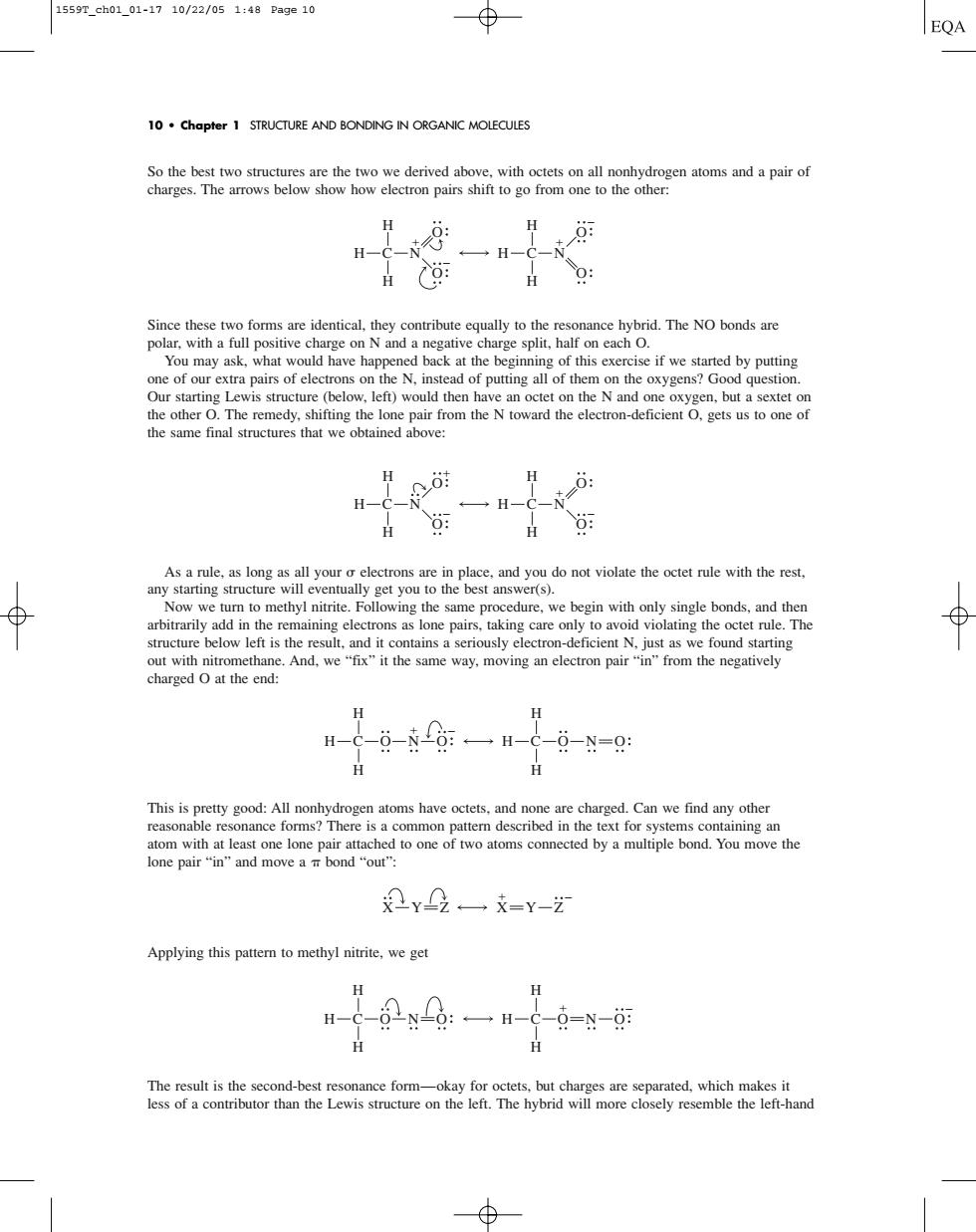正在加载图片...

1559Tch0101-1710/22/051:48Page10 10 chapter 1 STRUCTURE AND BONDING IN ORGANIC MOLECULES +8 H-C- H- H(9 H Since these two forms are identical.they contribute equally to the resonance hybrid.The NO bonds are polar,with a full positive charge on N and a negative charge split,half on eachO. may as d have hapeN kat the Our starting Lewis structure (below.left)would then have an octet on the Nand one en.but a sextet on H-C- 日o: ⊕ cedure,we begin with only single bonds,and then arbitrarily add in the remaining electrons as lone pairs.taking care only to avoid violating the octet rule.The charged O at the end: H-( 6-:一H-C--N=Q: H This i od:All nonby atom with at leas one pair 2y一=Y-艺 Applying this pattem to methyl nitrite.we get H 一H-C-=N- H The result is the second-best resonance form- -okay for octets.but charges are separated.which makes it less of a contributor than the Lewis structure on the left.The hybrid will more closely resemble the left-handSo the best two structures are the two we derived above, with octets on all nonhydrogen atoms and a pair of charges. The arrows below show how electron pairs shift to go from one to the other: Since these two forms are identical, they contribute equally to the resonance hybrid. The NO bonds are polar, with a full positive charge on N and a negative charge split, half on each O. You may ask, what would have happened back at the beginning of this exercise if we started by putting one of our extra pairs of electrons on the N, instead of putting all of them on the oxygens? Good question. Our starting Lewis structure (below, left) would then have an octet on the N and one oxygen, but a sextet on the other O. The remedy, shifting the lone pair from the N toward the electron-deficient O, gets us to one of the same final structures that we obtained above: As a rule, as long as all your electrons are in place, and you do not violate the octet rule with the rest, any starting structure will eventually get you to the best answer(s). Now we turn to methyl nitrite. Following the same procedure, we begin with only single bonds, and then arbitrarily add in the remaining electrons as lone pairs, taking care only to avoid violating the octet rule. The structure below left is the result, and it contains a seriously electron-deficient N, just as we found starting out with nitromethane. And, we “fix” it the same way, moving an electron pair “in” from the negatively charged O at the end: This is pretty good: All nonhydrogen atoms have octets, and none are charged. Can we find any other reasonable resonance forms? There is a common pattern described in the text for systems containing an atom with at least one lone pair attached to one of two atoms connected by a multiple bond. You move the lone pair “in” and move a bond “out”: Applying this pattern to methyl nitrite, we get The result is the second-best resonance form—okay for octets, but charges are separated, which makes it less of a contributor than the Lewis structure on the left. The hybrid will more closely resemble the left-hand H H H H C N O O H H C N O O X Y Z X Z Y H H H H C N O O H H C N O O H H H C N O O H H H C N O O H H H C N O O H H H C N O O 10 • Chapter 1 STRUCTURE AND BONDING IN ORGANIC MOLECULES 1559T_ch01_01-17 10/22/05 1:48 Page 10��������